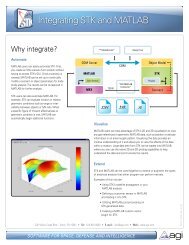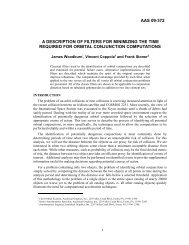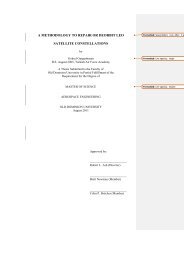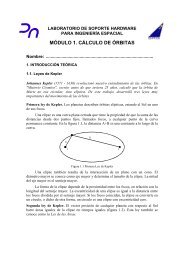SPACE WEATHER - AGI
SPACE WEATHER - AGI
SPACE WEATHER - AGI
- No tags were found...
Create successful ePaper yourself
Turn your PDF publications into a flip-book with our unique Google optimized e-Paper software.
Section III: Thermal Effects© SSS Educational Series 2012Although, the sun releases a stream of electrons and protons that escape due totheir high kinetic energy, these particles are not the primary source of thermalenergy of the solar wind. Overtime, as the high-energy particles released from thesun mix with one another in space, this causes turbulence and the generation ofthermal energy [9]. The stirring of the solar wind produces swirls and eddies whichbreakdown overtime and the thermal energy is dissipated as result of the mixingprocess [9, 10].3. Thermal Effects3.1 Governance of Thermal Output from the SunThermal radiation from the sun occurs through the release of visible light andinfrared radiation [11]. This occurs through fusion reactions from the ionised mixtureof hydrogen and helium gas in the sun’s core [11]. As the gas in the sun’s core is atvery high temperatures, thermal collisions between atoms will ionise them resultingin the ejection of electrons that will co-exist with atomic ions [11]. The thermalconductivity of the sun is dependent on the degree of ionisation of the atoms.Ionisation can be determined using the Saha ionisation equation [12], however thisequation is ideally applied in cases when the system is in equilibrium. As the sun isnot entirely in equilibrium since the solar chromosphere, corona and prominences arenot in radiative equilibrium (the heat generated from fusion is entirely transferred aselectromagnetic radiation from the sun into space), the ionisation capacity alone isnot enough to describe the thermal conductivity of the sun [13]. An improvedmethod to describe the conductivity of the sun takes into account the density of thevarious particles, the temperature and the ionisation energy of the atoms [13].Furthermore, in the presence of a strong magnetic field, heat conduction by chargedparticles across lines of force is greatly reduced and as a result the thermalconductivity is determined mainly by the remaining neutral particles (unionised formof He and H) [13]. In addition, heat conduction by neutral atoms plays a key rolewhen the system deviates from thermodynamic equilibrium in solar prominences andthe chromosphere. In these regions the electron temperature can exceed the localradiation temperature and as result ionisation is greatly reduced [13].The thermal conductivity is determined as follows [13]:Figure 11. Thermal Conductivity from the Sun. Where λ 1 =thermal conductivity,Γ 1 =conductivity of neutral particles, T=temperature, N=electron density,Γ 2 =conductivity of positively charged particles, Γ 3 =conductivity of negativelycharged particles24

















